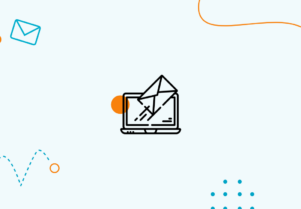How to Save Time by Automating Your Marketing Processes
If you are a marketer, or a business owner responsible for marketing your own business, then you’ve probably heard quite a lot about automation. Simply put, automation is like the holy grail of marketing.

When you use it effectively, you can save a huge amount of time and even make more money by putting technology such as marketing automation software to work for you. And the best part is that with so many great tools available, automating your marketing has become easier than ever.
When it comes to digital marketing and email marketing, in particular, leveraging marketing process automation is crucial. It allows for implementing a solid customer journey optimization strategy that saves time and money while acquiring more customers.
What is Marketing Automation?
Marketing automation refers to technologies designed to allow you to automate and measure various marketing activities, including strategies and workflows, to attract more prospective customers in a shorter period and boost your ROI.
When implemented effectively and correctly, marketing automation allows you to nurture your visitors better while taking them through an engaging journey that you will design with a customer journey optimization strategy. It gives you a better chance of converting your leads to lifetime customers who choose your brand over competitors and perhaps even become ambassadors for it.
When speaking about marketing automation, most people nowadays think of marketing automation software. These tools are used for various processes, such as email campaigns, live chat, scoring qualified leads, and more.
Think of using Mailchimp for email marketing, Intercom for chat, an IVR phone system for inbound calls, and similar. Whatever aspect of marketing you can think of, there is probably a great number of tools that can successfully automate it.
When to Invest in Automated Marketing
The best time to start thinking about automating your marketing strategy is once you have put together a customer journey strategy and have begun to see a steady flow of new visitors to your website, either from paid marketing campaigns, email marketing, or organic search results.
If you have a steady flow of traffic made up of primarily new visitors, are successfully producing engaging and relevant content to offer to leads, are managing to convert visitors to leads, and want to make your email marketing strategy more personalized, then it is worth considering automating your marketing campaigns.
Automation can also help you if you currently have a manual sales process and sales representatives for your business are struggling to generate enough revenue despite having more than enough leads.
It’s also a good idea if you want to increase revenue by scaling your strategy for nurturing leads and want to be able to develop stronger relationships with customers throughout the various stages of your sales funnel.
In other words, it’s always a good idea to invest in automated marketing. You can increase the following:
– customer engagement
– customer satisfaction
– customer loyalty
– overall campaign performance
– and many other aspects of your marketing, sales, and business processes
While it may seem that a couple of hundred dollars is a lot for a piece of software, the myriad of new leads flocking in will provide more than a good return on investment within marketing process automation.
Benefits of Using Marketing Process Automation
Marketing automation platforms can help you automate many repetitive tasks while streamlining marketing activities. As a result, your business becomes more efficient, and you can save a great deal of time and money with workflow automation.
The best part is that marketing automation is not only applicable to automated email marketing campaigns. Although email is a huge part of marketing automation, it is possible to automate almost any part of a digital marketing strategy.
Some of the main benefits of automating marketing include the following:
1 – Faster Lead Qualifying and Nurturing
Lead nurturing is one of the top reasons why marketers and business owners turn to marketing automation. With marketing automation tools, you can easily segment and qualify cold and warm leads, helping you better identify potential customers throughout the customer lifecycle.
Lead scoring is often a part of this process, which involves allocating different scores to leads based on the actions that they have taken both on and off your website. This is especially important in B2B marketing where a B2B lead scoring model can help prioritize and focus your sales and marketing efforts on leads that are more likely to convert into paying customers.
You can also apply the usual data attributes such as survey answers, demographics, and more. Discover why it’s essential to verify email addresses with Bouncer.
For example, someone who opened your email, clicked through to your website, and watched a few product videos is a much better lead compared to someone who just subscribed to your newsletter.
The end result is higher-quality leads with less marketing efforts and without using manual processes.
2 – Integrate Marketing and Sales
Today, digital marketing is evolving so that the line separating sales and marketing is becoming increasingly blurred. Various tools available will bring leads from the nurturing cycle to the sales department, where your brand can engage with them further. The traditional divide between sales and marketing will be almost deleted in the future.
Along with this, there are now more native integrations between marketing automation tools and CRM tools available, which allow for more alignment than ever before between the marketing and sales teams. Learn how often you should clean your email list.
And if you think something cannot be connected, just try tools such as Zapier or IFTT and you’ll see what a world of opportunities is unlocked. All it takes is some basic research and you can save hours of time and boatloads of cash for your business.
Automation creates processes across the two departments and leads to a greater marketing and sales alignment. It brings the two together to develop strategies to use and determine which marketing KPIs should be tracked, such as conversion rates or ROAS. Ultimately, this leads to a more integrated, seamless approach to improving the customer journey and providing a personalized experience for customers.
3 – More Up-to-Date and Accurate Data
Automating marketing makes many different marketing tasks more straightforward, but it also takes much of the hard work out of reporting. When everything is digitized, all it takes is a couple of clicks to track key performance metrics easily with one marketing automation solution. Check if an email address is valid with Bouncer.
Straight away, using an email marketing or other marketing automation platform allows you to measure things that you would struggle to do so otherwise, such as bounce rates and open rates. And automation can also provide you with further insights into useful things like customer behavior when they are visiting your website or the types of promotional materials that are more likely to get you the desired response. Understand the importance of email open rates.
Even when metrics are available for you to track without using automation tools, using automation platforms removes the human error side of things and eliminates the time it takes to perform them manually. When you use automation platforms, you will have more confidence in the accuracy of your analytics reports, thanks to marketing automation workflows.
4 – Boost Conversions
Automation of your marketing strategy won’t just make your life easier and help you save time – it will also help to improve your bottom line. Learn about the main types of email accounts.
So, it’s no surprise that companies today increasingly recognize the effectiveness of marketing automation and continue increasing their investment in this area. Automation brings a lot to the table, which is often more valuable than any other investment as long as you use the right tools.
Marketing automation is so well-known for boosting conversions, along with other benefits, that over 50% of companies are now using it, and almost 60% of B2B businesses are planning to start using some kind of marketing automation software in the near future to eliminate manual tasks after a certain period of time.
With marketing automation, it’s possible to send real time messages to your target audience, designed to boost engagement and sales faster and more easily compared to having somebody do it manually. This alone will naturally cause the chance of successful conversions to increase.
5 – Improve Team Collaboration
Marketing covers various digital marketing channels, including SEO, social media, email marketing, paid advertising, and more. Generally, marketing teams are made up of different departments to look after each channel. They need to communicate with one another to ensure that they create and maintain a coherent marketing campaign, whether it’s Google Ads or various social media platforms.
If your business is not using any software to organize the work and ensure that collaboration is possible, chances are that things are a bit messy when it comes to your teamwork. If the communication and collaboration between team members are not streamlined, it becomes difficult for them to work efficiently together.
6 – Improve Customer Experience
The customer experience isn’t just a buzzword or catchphrase used by businesses. It is a crucial goal that is centered around putting your customers’ needs at the forefront of everything that your business does.
Increasingly, marketing automation is being used to achieve that goal by ensuring that targeted, meaningful interactions are being delivered to customers across various channels and stages of the sales cycle.
When your business can market the product or service that it offers in a personal way, this leads customers to feel that your company cares about their needs.
Companies today that are serious about improving the customer experience will often make serious investments in marketing automation. Their main aim is to make sure that the right content is provided when the customer reaches a certain touch point, to ensure that the right, relevant product recommendations are made, engaging follow-up emails are sent, and customers who have abandoned their carts are contacted and followed up with to encourage them to come back.
7 – Discover What Works and What Doesn’t
With marketing automation, you can instantly and accurately see what is working and what isn’t when it comes to your campaign. When you have this information, it becomes easier to adjust your operations accordingly and create more effective campaigns with great automation technologies.
To do this successfully, many companies use A/B or split testing, which is often a feature that is offered by various marketing automation platforms. Once you have the initial data, have built some hypotheses, and tested them, you can collect more data and repeat the process with several elements until it has become clear what’s performing best.
Many automation tools that offer split testing are also highly flexible, which makes them appealing to businesses. With many of the best marketing automation tools, you can A/B test your marketing automation strategies in a few simple steps.
Whether you are testing the performance of different call to action button colors or different forms of copy for an email newsletter subject line, you can set up tests effortlessly to ensure that you are always using the strategies that have been proven to work best.
The same applies to all customer-facing communication, such as your blog content, landing pages, content creation, social media ads, and more.
Marketing automation isn’t just about saving time and reducing manual marketing tasks. It can also help to improve the customer experience and ultimately bring in more revenue.
Discover marketing process automation
Marketing automation systems are the future of marketing to customers and there is no denying it. With artificial intelligence making huge breakthroughs in all aspects of marketing, it is time for marketers to adopt business process automation sooner rather than later.
With Bouncer, you can make sure you’re marketing to the right people.
Use Bouncer to clean up and validate your email lists for better email marketing metrics, a pristine sender reputation, and ultimately, more revenue.
Marketing process automation: frequently asked questions
What is the difference between good and back marketing automation?
Good marketing process automation takes into account more than just customers’ behavior. It considers their characteristics, unique buyer persona, previous purchasing history and all the fine details that make the customer journey that more personalized.
What should I automate first in my marketing strategy?
We may be slightly biased here, but you should start your automation journey with email marketing. With so many automation features existing in current email marketing software, it is by far the easiest and most lucrative method to get the best bang for your buck in a short period of time.
Why does marketing process automation fail?
It depends on case to case basis, but most often, it fails because of a lack of personalization. Effective marketing automation means combining effectiveness with a personalized approach to customers through your preferred digital platform.






